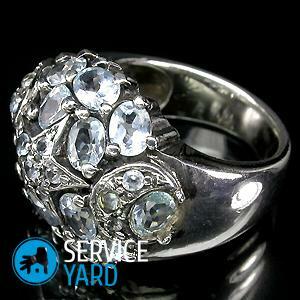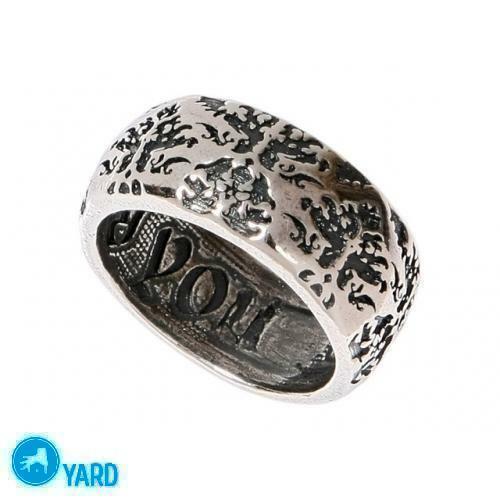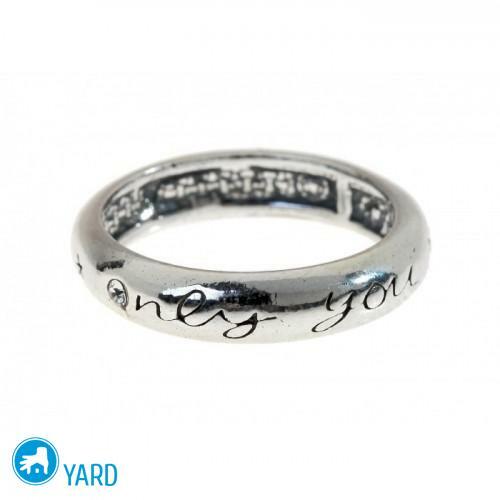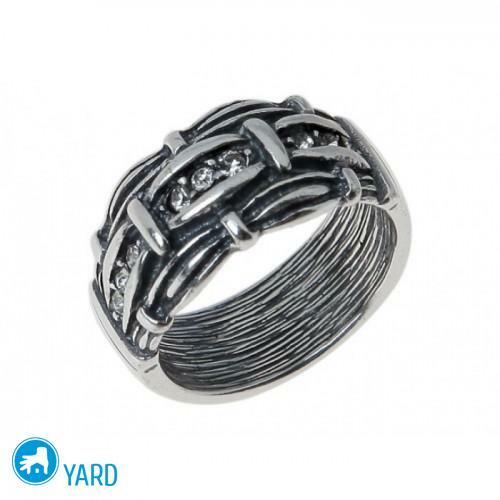
- Types of silver and their application
- History of the appearance of blackened silver
- Blackened silver. What it is?
- Silvering methods for silver
- Blackening of silver at home
- Care for blackened silver products
- How to distinguish blackened silver from oxidized?
Every year jewelry becomes more and more popular in the market, and in the cities there is an increasing number of stores and stores selling jewelry, although raw materials and production are declining. The most popular and popular, of course, are gold and silver, and of all kinds of the latter - blackened silver, whose products are distinguished by refinement and beauty. Silver is durable, inexpensive, besides, a man does not age, so both adults and children can wear it.
to content ↑Types of silver and their application
Unlike precious metal - gold, the appearance of silver does not have a variety. Silver always has a white-silver color, but gold can be yellow, pink, red, etc.
Nevertheless, different types of silver are distinguished:
- Matte.
- Filigree.
- Sterling.
- Coin.
- Blackened silver.

Each kind of metal has its own characteristics:
- Matte silver does not have bright patterns. Obtain this kind of metal by using different emulsions, applying them to the raw materials. This technology gives the metal some roughness. This kind of silver looks very beautiful and original.
- On filigree silver, unlike matte, on the contrary, different multiple openwork patterns are created. This is achieved due to the fact that the silver has a high strength, ductility, which makes it possible to produce fine yarns. They, like a wire, give the products a picture. This technique of manufacturing products requires special skill, skill and plenty of time. Distinguish the filigree filigree and background. In products made from delicate filigree, the pattern has a through character, and with a background pattern, a lacy pattern is attached, so to speak, to the background, in the role of which, for example, the moonstone appears.
- Sterling silver is the main material for jewelry. This type of metal has a smooth surface, white-silver color, has high strength. The composition of sterling silver is 92.5% pure metal, and the rest - the addition of copper.
- Blackened silver - what is it? This material is obtained due to the chemical reaction of the metal with sulfur, which is contained in air in microdoses. Pure silver is almost inert to sulfur, so the reaction is too slow. As a rule, products made of precious metal alloys quickly darken, as copper is less resistant to sulfur and more quickly reacts with it. Blackened silver can be of two types: the first is formed naturally, and the second - by the hands of the jeweler.
History of the appearance of blackened silver
For a long time craftsmen and craftsmen decorated household items and weapons with various ornaments, patterns and drawings. Constantly improving in this area, the masters invented a special way of metal processing - silvering( at home, many craftsmen do it today to decorate their items).
Important! Mobile is an ancient device of giving gold and silver ornaments of black color. After applying this technique, the surface of the product becomes more contrasted and richer, whether it is a detail of the relief or a pattern of an ornament. This same technology is used to conceal small defects and joints.
The principle of creating
The essence of the blackening is this: an alloy of silver, copper, lead, sulfur is fused into the base metal. The alloy for blackening is fused into the grooves marked on the choice:
- Engraving.
- Embossing.
- Hardening.
- Etching.
The grooves are made small - 0.3 mm. Under the influence of high temperatures, a chemical reaction occurs between the fused mixture and silver. In addition to decorative qualities, blackened with this technique products, and receive practical properties: decorations do not fade, do not require special care. A palette of blackening can be varied: from silvery gray to black and velvet tone.
Important! The blackening looks very nice and on gold, however it is extremely difficult to deduce the composition of the black on noble metal. Therefore, the black on gold is extremely rare. On metals such as copper, brass and low-grade silver, the black crumbles and disappears, so from time immemorial and until nowadays, only silvering is most often used - it is durable and exquisitely beautiful.
Where do the blackening of silver?
Intentionally changing the type of metal, it became widespread in the 17th century. Great popularity of blackened silver was acquired in Veliky Ustyug( Russia), where folk craft originated.
Important! A vast exposition of products of masters from Ustyug is kept in the State Ethnographic Museum. The most famous exhibit of the collection is a cast cross, which is not only made of blackened silver, but also gilded.
In the European part of the country, jewels and household items made of blackened silver were very popular in the 17th and 18th centuries. Especially famous were the works of the master Mikhail Klimshin from Veliky Ustyug.
Important! It was fashionable and prestigious to have from such metal dishes, cigarette cases, trays, coasters, snuffboxes, cutlery, engravings. On items from silver, various ornaments, hunting pictures, cities and geographical maps were depicted.
First, precious metal articles were produced in private workshops, and then proceeded to industrial production in special factories. Since that time, to train the silvering silverware have become ordinary people, including, and with the merchant class. The demand for silver always took place, and today you can still find real works of art that are simply priceless.
to the contents ↑Blackened silver. What it is?
Blackened silver is pure silver covered with black on special technology. The product is first minted, etched, and then degreased and applied a special coating composition. And in order for the black to melt and cover the surface, the product is specially heated to a certain temperature.

Techniques for silvering
For many years, the technician of creating dark patterns on metal has accumulated a lot. Here are just three of them:
- The German recipe for a rough mix assumes a slow infusion of lead into a copper-silver alloy, thoroughly mixing. Then, the triple obtained alloy is poured into the heated sulfur powder, thoroughly mixing for the qualitative interaction of the components. The resulting mixture is poured into water, after which the frozen pieces of black are finely and finely ground in a porcelain mortar in the required dose. Fresh wet black mass is applied to the object.
- The Russian recipe recommends portions of sulfur to be added to the alloy, not the triple alloy, to sulfuric powder, as in the previous recipe. In addition, the ready mobile is poured not into the water, but into a cast-iron frying pan. The resulting hard "pancake" is broken into pieces, and then melted, adding sulfur and flux. If you need extra-class mobile, the process is repeated three times. The prepared mob is pounded in a mortar and sifted through a fine sieve.
- Recipe of Professor AG Spassky. The author worked at the Moscow Institute of Non-Ferrous Metals and proposed the following method of preparing mallow: separately prepared sulphurous silver, copper sulphide and sulphurous lead are fused together in the right proportions. After - the resulting mixture in a strictly defined way is melted and cooled.
Methods of drawing of mobile
Silvering can be performed:
- Dry method. The surface of the product is moistened with the necessary solution, after which a very fine grinding powder is applied. After that, the products are dried and fired in a muffle at a temperature of 300-400 degrees Celsius.
- Wet method. The composition is applied to the surface in the form of a creamy slurry, diluted with water. With a spatula or brush, the mixture is densely and densely applied to the indentations. Then wait until the water evaporates. When incandescent in a muffle, the applied composition melts and flows into the pattern, covering the object. After all the procedures, the product is removed from the stove.
Important! Small items can be melted with a soldering gun, the heat flow is concentrated on the base metal from the back side. After the mixture melts, heat is completed.
After the process of depositing the mobile, the product is "cleaned" by shabbing or processed with a file until the figure appears. Do this very carefully, so as not to capture and do not deform the ornament itself. Then - it remains only to polish the product and polish it, until the whole picture appears.
to the contents ↑Methods of blackening of silver
To obtain "blackness" on silver products, it is necessary to achieve the effect of deposition of sulfur on the surface. You can do this in the following ways:
Mechanical
Mechanical is the easiest way to make silvering at home. To carry out your plan, you will need graphite, mixed with iron oxide and turpentine.
Mixture of ingredients, applied as a gruel to silver objects and waiting until completely dry. Remove the product from the product with a soft brush or suede cloth. After that, the protruding places of the object are rubbed with alcohol.
Important! As a result of this technique, silver things turn out to be artificially aged.
Disadvantages of the method:
- Minimal adhesion to the surface of the product.
- Used for a small number of ornaments.
- Clear from blackening such products is very easy.
Chemical
Chemical - is the most durable and effective. The principle of this method is to fill with a mixture of black, engraved sections of the product. About this method, we described in detail above.
Electroplating
Galvanic - used in production and requires special equipment. The essence of the method: metal oxides are precipitated on silver objects in special baths by electrolysis. On the perimeter of the bath creates one charge, and on the alloy - another. As a result, plus and minus are attracted and create the necessary shade to the object.
to the contents ↑Blackening of silver at home
To make a galvanic bath for one bracelet or ring, of course, no one will, but what if you want to have earrings of blackened silver, and only ordinary ones available? There are many simplified methods used at home, which are used in case you need to blacken the chain or vase. Of course, blackening of silver at home is a very harmful and malicious matter, but if the desire to act uncontrollably, then we suggest that you use the following recipes and methods.
Method number 1
To prepare the mixture you will need:
- Egg. Tightly closed plastic container.
- Line or thin thread.
Use the items prepared as follows:
- Clean the silver product from contamination.
- Cook the egg.
- Cut the egg in half.
- Place the two halves of the product on the bottom of the container.
- Hang the silver ornament on the rope.
- Leave the product in the sealed container for 30 minutes( not less than).
- Turn over the ornament from time to time, to create a uniform blackness.

Important! The principle of operation is based on the enveloping of hydrogen sulfide vapors that are released from the product, ornaments. The resulting coating is durable and stable. This method can be used for items with precious stones, but after the silvering procedure at home, stones should be carefully wiped so that they do not lose their natural shine.
Method # 2
Use a iodine to smear a product:
- Use a cotton swab to apply iodine to the decoration.
- Leave to dry in the sun.
- Polish the decoration. On a rag, apply toothpaste and wipe the product: in the convex places there will be silver light, and in hard to reach, relief - dark.
Important! Use this method only for jewelry with intricate patterns, and they will look exquisite, on flat objects do not use this method, because in this case it is not effective.
Method # 3
Sulfuric ointment will give an antique look to silverware. Use the remedy as follows:
- Completely lubricate the object with ointment.
- Heat the product with a hairdryer. As it warms up, a black-violet hue will appear on the surface.
- After the blackening process, the decoration is polished.
Care for products made of blackened silver
The charm of aged products is that they do not need to be cleaned and they do not need polishing. However, to remove dust and dirt from ornaments, from time to time, it is still necessary. Do this carefully so as not to remove the top layer. Use for the cleaning procedure linen cloths and simple detergents, the main thing is that they are not aggressive.
Important! Do not use harsh chemicals such as ammonia or acetone for cleaning. Do not boil black jewelry and do not polish with products containing sharp abrasive particles.
Consider a few simple ways to clean jewelry:
- Use a soapy solution with a pinch of soda. Place the jewelry in the solution for 15-20 minutes, and then, rinse the objects under a stream of warm water. Wipe the products dry.
- Peel and cut raw potatoes with cold water. Leave ornaments in the container with the remedy for 3-4 hours. Wash the objects thoroughly and wipe them with a soft cloth.
- 15 grams of soda is dissolved in a glass of water. In a solution, rinse contaminated products.
- Remove any contaminants on the surface of the object with an eraser. Rinse the decoration.
How to distinguish blackened silver from oxidized?
Blacking of silver is a very laborious and complex process, and therefore in the price this kind of metal is much more expensive than usual silver. But to find blackened among oxidized silver is very difficult.
Important! At its core, oxidation is the coating of metal with a film that protects against tarnishing and gives the product refinement. However, the oxide film will not make the decoration qualitative and durable, but on the contrary - after buying the product can lose its original appearance in a short time.
To not regret buying, carefully look at the decoration:
- Products covered with oxide film, look too smooth and only slightly darkened. Blackened silver has a rich black color, which is combined with light areas.
- The patterns on the products of blackened silver look very noble and executed neatly.
- This silver with elements of blackening is more expensive than other types of noble metal. The cost of products includes: a sample of silver, the complexity of the pattern, the presence of precious stones, blacking technology, the complexity of the work of the master.
- When cleaning oxidised silver on the product, white areas are formed, and blackened silver is resistant to both cleaning and polishing. Loss of their blackness such a metal can only with prolonged boiling or when immersed in acid.
Stylish silver jewelry with elements of blackening is ideal for important events and special occasions. They suit both the costume and the classic dress. But for unusual and mysterious ornaments to serve you as long as possible, and in the future become a relic, store them in dark boxes - where the sun does not penetrate. Such decorations are worthy of careful attitude and admiration.



